INTRODUCTION
TO
LINEAR
ALGEBRA
Fifth Edition
MANUAL FOR INSTRUCTORS
Gilbert Strang
Massachusetts Institute of Technology
math.mit.edu/linearalgebra
web.mit.edu/18.06
video lectures: ocw.mit.edu
math.mit.edu/∼gs
www.wellesleycambridge.com
email: linearalgebrabook@gmail.com
Wellesley - Cambridge Press
Box 812060
Wellesley, Massachusetts 02482
�
2
Problem Set 1.1, page 8
SolutionstoExercises
1 The combinations give (a) a line in R3
(b) a plane in R3
(c) all of R3.
2 v + w = (2, 3) and v − w = (6,−1) will be the diagonals of the parallelogram with
v and w as two sides going out from (0, 0).
3 This problem gives the diagonals v + w and v − w of the parallelogram and asks for
the sides: The opposite of Problem 2. In this example v = (3, 3) and w = (2,−2).
4 3v + w = (7, 5) and cv + dw = (2c + d, c + 2d).
5 u+v = (−2, 3, 1) and u+v+w = (0, 0, 0) and 2u+2v+w = ( add first answers) =
(−2, 3, 1). The vectors u, v, w are in the same plane because a combination gives
(0, 0, 0). Stated another way: u = −v − w is in the plane of v and w.
6 The components of every cv + dw add to zero because the components of v and of w
add to zero. c = 3 and d = 9 give (3, 3,−6). There is no solution to cv+dw = (3, 3, 6)
because 3 + 3 + 6 is not zero.
7 The nine combinations c(2, 1) + d(0, 1) with c = 0, 1, 2 and d = (0, 1, 2) will lie on a
lattice. If we took all whole numbers c and d, the lattice would lie over the whole plane.
8 The other diagonal is v − w (or else w − v). Adding diagonals gives 2v (or 2w).
9 The fourth corner can be (4, 4) or (4, 0) or (−2, 2). Three possible parallelograms!
10 i − j = (1, 1, 0) is in the base (x-y plane). i + j + k = (1, 1, 1) is the opposite corner
from (0, 0, 0). Points in the cube have 0 ≤ x ≤ 1, 0 ≤ y ≤ 1, 0 ≤ z ≤ 1.
11 Four more corners (1, 1, 0), (1, 0, 1), (0, 1, 1), (1, 1, 1). The center point is ( 1
2 ), ( 1
Centers of faces are ( 1
2 , 1) and (0, 1
2 , 1
2 , 0), ( 1
2 ) and ( 1
2 , 1
2 ), (1, 1
2 , 1
2 , 0, 1
2 , 1
2 , 1
2 , 1
2 ).
2 , 1, 1
2 ).
12 The combinations of i = (1, 0, 0) and i + j = (1, 1, 0) fill the xy plane in xyz space.
13 Sum = zero vector. Sum = −2:00 vector = 8:00 vector. 2:00 is 30◦ from horizontal
= (cos π
6 , sin π
6 ) = (√3/2, 1/2).
14 Moving the origin to 6:00 adds j = (0, 1) to every vector. So the sum of twelve vectors
changes from 0 to 12j = (0, 12).
�
SolutionstoExercises
3
15 The point
v +
w is three-fourths of the way to v starting from w. The vector
3
4
1
4
w is halfway to u =
1
4
v +
1
4
parallelogram).
1
2
v +
1
2
w. The vector v + w is 2u (the far corner of the
16 All combinations with c + d = 1 are on the line that passes through v and w.
The point V = −v + 2w is on that line but it is beyond w.
17 All vectors cv + cw are on the line passing through (0, 0) and u = 1
2 w. That
line continues out beyond v + w and back beyond (0, 0). With c ≥ 0, half of this line
is removed, leaving a ray that starts at (0, 0).
2 v + 1
18 The combinations cv + dw with 0 ≤ c ≤ 1 and 0 ≤ d ≤ 1 fill the parallelogram with
sides v and w. For example, if v = (1, 0) and w = (0, 1) then cv + dw fills the unit
square. But when v = (a, 0) and w = (b, 0) these combinations only fill a segment of
a line.
19 With c ≥ 0 and d ≥ 0 we get the infinite “cone” or “wedge” between v and w. For
example, if v = (1, 0) and w = (0, 1), then the cone is the whole quadrant x ≥ 0, y ≥
0. Question: What if w = −v? The cone opens to a half-space. But the combinations
of v = (1, 0) and w = (−1, 0) only fill a line.
20 (a) 1
3 u + 1
3 v + 1
between u and w
3 w is the center of the triangle between u, v and w; 1
2 w lies
(b) To fill the triangle keep c≥ 0, d≥ 0, e≥ 0, and c + d + e = 1.
21 The sum is (v− u) + (w− v) + (u− w) = zero vector. Those three sides of a triangle
2 u + 1
are in the same plane!
22 The vector 1
2 (u + v + w) is outside the pyramid because c + d + e = 1
2 + 1
2 + 1
2 > 1.
23 All vectors are combinations of u, v, w as drawn (not in the same plane). Start by
seeing that cu + dv fills a plane, then adding ew fills all of R3.
24 The combinations of u and v fill one plane. The combinations of v and w fill another
plane. Those planes meet in a line: only the vectors cv are in both planes.
25 (a) For a line, choose u = v = w = any nonzero vector
(b) For a plane, choose
u and v in different directions. A combination like w = u + v is in the same plane.
�
4
SolutionstoExercises
26 Two equations come from the two components: c + 3d = 14 and 2c + d = 8. The
solution is c = 2 and d = 4. Then 2(1, 2) + 4(3, 1) = (14, 8).
27 A four-dimensional cube has 24 = 16 corners and 2 · 4 = 8 three-dimensional faces
and 24 two-dimensional faces and 32 edges in Worked Example 2.4 A.
28 There are 6 unknown numbers v1, v2, v3, w1, w2, w3. The six equations come from the
components of v + w = (4, 5, 6) and v − w = (2, 5, 8). Add to find 2v = (6, 10, 14)
so v = (3, 5, 7) and w = (1, 0,−1).
29 Two combinations out of infinitely many that produce b = (0, 1) are −2u + v and
2 v. No, three vectors u, v, w in the x-y plane could fail to produce b if all
2 w − 1
three lie on a line that does not contain b. Yes, if one combination produces b then two
1
(and infinitely many) combinations will produce b. This is true even if u = 0; the
combinations can have different cu.
30 The combinations of v and w fill the plane unless v and w lie on the same line through
(0, 0). Four vectors whose combinations fill 4-dimensional space: one example is the
“standard basis” (1, 0, 0, 0), (0, 1, 0, 0), (0, 0, 1, 0), and (0, 0, 0, 1).
31 The equations cu + dv + ew = b are
= 1
2c −d
−c +2d −e = 0
−d +2e = 0
So d = 2e
then c = 3e
then 4e = 1
c = 3/4
d = 2/4
e = 1/4
Problem Set 1.2, page 18
1 u · v = −2.4 + 2.4 = 0, u · w = −.6 + 1.6 = 1, u · (v + w) = u · v + u · w =
0 + 1, w · v = 4 − 6 = −2 = v · w.
2 kuk = 1 and kvk = 5 and kwk = √5. Then |u · v| = 0 < (1)(5) and |v · w| = 10 <
5√5, confirming the Schwarz inequality.
�
SolutionstoExercises
5
5 , 3
3 Unit vectors v/kvk = ( 4
5 ) = (0.8, 0.6). The vectors w, (2,−1), and −w make
0 ◦, 90 ◦, 180 ◦ angles with w and w/kwk = (1/√5, 2/√5). The cosine of θ is v
kvk ·
w
kwk
= 10/5√5.
)−(
4 (a) v · (−v) = −1
(b) (v + w) · (v − w) = v · v + w · v − v · w − w · w =
(c) (v−2w)·(v+2w) =
)−1 = 0 so θ = 90◦ (notice v·w = w·v)
1+(
v · v − 4w · w = 1 − 4 = −3.
5 u1 = v/kvk = (1, 3)/√10 and u2 = w/kwk = (2, 1, 2)/3. U 1 = (3,−1)/√10 is
perpendicular to u1 (and so is (−3, 1)/√10). U 2 could be (1,−2, 0)/√5: There is a
whole plane of vectors perpendicular to u2, and a whole circle of unit vectors in that
plane.
6 All vectors w = (c, 2c) are perpendicular to v. They lie on a line. All vectors (x, y, z)
with x + y + z = 0 lie on a plane. All vectors perpendicular to (1, 1, 1) and (1, 2, 3)
lie on a line in 3-dimensional space.
0 so θ = 90◦ or π/2 radians
7 (a) cos θ = v · w/kvkkwk = 1/(2)(1) so θ = 60◦ or π/3 radians
(d) cos θ = −1/√2 so θ = 135◦ or 3π/4.
8 (a) False: v and w are any vectors in the plane perpendicular to u (b) True: u ·
(c) True, ku − vk2 = (u − v) · (u − v) splits into
(c) cos θ = 2/(2)(2) = 1/2 so θ = 60◦ or π/3
(b) cos θ =
(v + 2w) = u · v + 2u · w = 0
u · u + v · v = 2 when u · v = v · u = 0.
9 If v2w2/v1w1 = −1 then v2w2 = −v1w1 or v1w1 + v2w2 = v· w = 0: perpendicular!
The vectors (1, 4) and (1,− 1
4 ) are perpendicular.
10 Slopes 2/1 and −1/2 multiply to give −1: then v · w = 0 and the vectors (the direc-
tions) are perpendicular.
11 v · w < 0 means angle > 90◦; these w’s fill half of 3-dimensional space.
12 (1, 1) perpendicular to (1, 5)− c(1, 1) if (1, 1)· (1, 5)− c(1, 1)· (1, 1) = 6− 2c = 0 or
c = 3; v · (w − cv) = 0 if c = v · w/v · v. Subtracting cv is the key to constructing
a perpendicular vector.
�
6
SolutionstoExercises
13 The plane perpendicular to (1, 0, 1) contains all vectors (c, d,−c). In that plane, v =
(1, 0,−1) and w = (0, 1, 0) are perpendicular.
14 One possibility among many: u = (1,−1, 0, 0), v = (0, 0, 1,−1), w = (1, 1,−1,−1)
and (1, 1, 1, 1) are perpendicular to each other. “We can rotate those u, v, w in their
3D hyperplane and they will stay perpendicular.”
2 (x + y) = (2 + 8)/2 = 5 and 5 > 4; cos θ = 2√16/√10√10 = 8/10.
15 1
3 , . . . , 1
16 kvk2 = 1 + 1 +··· + 1 = 9 so kvk = 3; u = v/3 = ( 1
3 ) is a unit vector in 9D;
w = (1,−1, 0, . . . , 0)/√2 is a unit vector in the 8D hyperplane perpendicular to v.
17 cos α = 1/√2, cos β = 0, cos γ = −1/√2. For any vector v = (v1, v2, v3) the
3)/kvk2 = 1.
18 kvk2 = 42 + 22 = 20 and kwk2 = (−1)2 + 22 = 5. Pythagoras is k(3, 4)k2 = 25 =
cosines with (1, 0, 0) and (0, 0, 1) are cos2 α+cos2 β+cos2 γ = (v2
2+v2
1+v2
20 + 5 for the length of the hypotenuse v + w = (3, 4).
19 Start from the rules (1), (2), (3) for v · w = w · v and u · (v + w) and (cv) · w. Use
rule (2) for (v + w) · (v + w) = (v + w) · v + (v + w) · w. By rule (1) this is
v · (v + w) + w · (v + w). Rule (2) again gives v · v + v · w + w · v + w · w =
v · v + 2v · w + w · w. Notice v · w = w · v! The main point is to feel free to open
up parentheses.
20 We know that (v − w)· (v − w) = v · v − 2v · w + w · w. The Law of Cosines writes
kvkkwk cos θ for v · w. Here θ is the angle between v and w. When θ < 90◦ this
v · w is positive, so in this case v · v + w · w is larger than kv − wk2.
Pythagoras changes from equality a2+b2 = c2 to inequality when θ < 90 ◦ or θ > 90 ◦.
21 2v· w ≤ 2kvkkwk leads to kv + wk2 = v · v + 2v· w + w· w ≤ kvk2 + 2kvkkwk +
22 v2
1 + 2v1w1v2w2 + v2
kwk2. This is (kvk + kwk)2. Taking square roots gives kv + wk ≤ kvk + kwk.
2w2
1w2
because the difference is v2
2 is true (cancel 4 terms)
1 + v2
1w2
2 ≤ v2
1 − 2v1w1v2w2 which is (v1w2 − v2w1)2 ≥ 0.
2w2
2 + v2
1w2
23 cos β = w1/kwk and sin β = w2/kwk. Then cos(β−a) = cos β cos α+sin β sin α =
v1w1/kvkkwk + v2w2/kvkkwk = v · w/kvkkwk. This is cos θ because β − α = θ.
2 + v2
1 + v2
1w2
2w2
2w2
�
SolutionstoExercises
7
2 (u2
24 Example 6 gives |u1||U1| ≤ 1
1 + U 2
becomes .96 ≤ (.6)(.8) + (.8)(.6) ≤ 1
25 The cosine of θ is x/px2 + y2, near side over hypotenuse. Then | cos θ|2 is not greater
than 1: x2/(x2 + y2) ≤ 1.
2 ). The whole line
2 (.82 + .62) = 1. True: .96 < 1.
1 ) and |u2||U2| ≤ 1
2 (.62 + .82) + 1
2 + U 2
2 (u2
26 The vectors w = (x, y) with (1, 2) · w = x + 2y = 5 lie on a line in the xy plane. The
shortest w on that line is (1, 2). (The Schwarz inequality kwk ≥ v · w/kvk = √5 is
an equality when cos θ = 0 and w = (1, 2) and kwk = √5.)
27 The length kv − wk is between 2 and 8 (triangle inequality when kvk = 5 and kwk =
3). The dot product v · w is between −15 and 15 by the Schwarz inequality.
28 Three vectors in the plane could make angles greater than 90◦ with each other: for
example (1, 0), (−1, 4), (−1,−4). Four vectors could not do this (360◦ total angle).
How many can do this in R3 or Rn? Ben Harris and Greg Marks showed me that the
answer is n + 1. The vectors from the center of a regular simplex in Rn to its n + 1
vertices all have negative dot products. If n+2 vectors in Rn had negative dot products,
project them onto the plane orthogonal to the last one. Now you have n + 1 vectors in
Rn−1 with negative dot products. Keep going to 4 vectors in R2 : no way!
29 For a specific example, pick v = (1, 2,−3) and then w = (−3, 1, 2). In this example
cos θ = v · w/kvkkwk = −7/√14√14 = −1/2 and θ = 120◦ . This always
happens when x + y + z = 0:
v · w = xz + xy + yz =
This is the same as v · w = 0 −
(x + y + z)2 −
(x2 + y2 + z2)
1
2 kvkkwk. Then cos θ =
1
2
.
1
2
1
2
30 Wikipedia gives this proof of geometric mean G = 3√xyz ≤ arithmetic mean
A = (x + y + z)/3. First there is equality in case x = y = z. Otherwise A is
somewhere between the three positive numbers, say for example z < A < y.
Use the known inequality g ≤ a for the two positive numbers x and y + z − A. Their
mean a = 1
2 (3A − A) = same as A! So a ≥ g says that
2 (x + y + z − A) is 1
�
8
SolutionstoExercises
A3 ≥ g2A = x(y + z − A)A. But (y + z − A)A = (y − A)(A − z) + yz > yz.
Substitute to find A3 > xyz = G3 as we wanted to prove. Not easy!
There are many proofs of G = (x1x2 ··· xn)1/n ≤ A = (x1 + x2 + ··· + xn)/n. In
calculus you are maximizing G on the plane x1 + x2 + ··· + xn = n. The maximum
occurs when all x’s are equal.
31 The columns of the 4 by 4 “Hadamard matrix” (times 1
2 ) are perpendicular unit
vectors:
1
2
H =
1
2
1
1
1
1
1 −1
1
1 −1
1 −1 −1
1
1 −1 −1
.
32 The commands V = randn (3, 30); D = sqrt (diag (V ′ ∗ V )); U = V \D; will give
30 random unit vectors in the columns of U. Then u ′ ∗ U is a row matrix of 30 dot
products whose average absolute value may be close to 2/π.
Problem Set 1.3, page 29
1 2s1 + 3s2 + 4s3 = (2, 5, 9). The same vector b comes from S times x = (2, 3, 4):
1 0 0
1 1 0
1 1 1
2
3
4
=
(row 1) · x
(row 2) · x
(row 2) · x
=
2
5
9
.
2 The solutions are y1 = 1, y2 = 0, y3 = 0 (right side = column 1) and y1 = 1, y2 = 3,
y3 = 5. That second example illustrates that the first n odd numbers add to n2.
y1
3
y1 + y2
= B1
= B2
gives
y1 + y2 + y3 = B3
y1 = B1
y2 = −B1 +B2
y3 =
−B2 +B3
=
1
0 0
1 0
−1
0 −1 1
B1
B2
B3
�
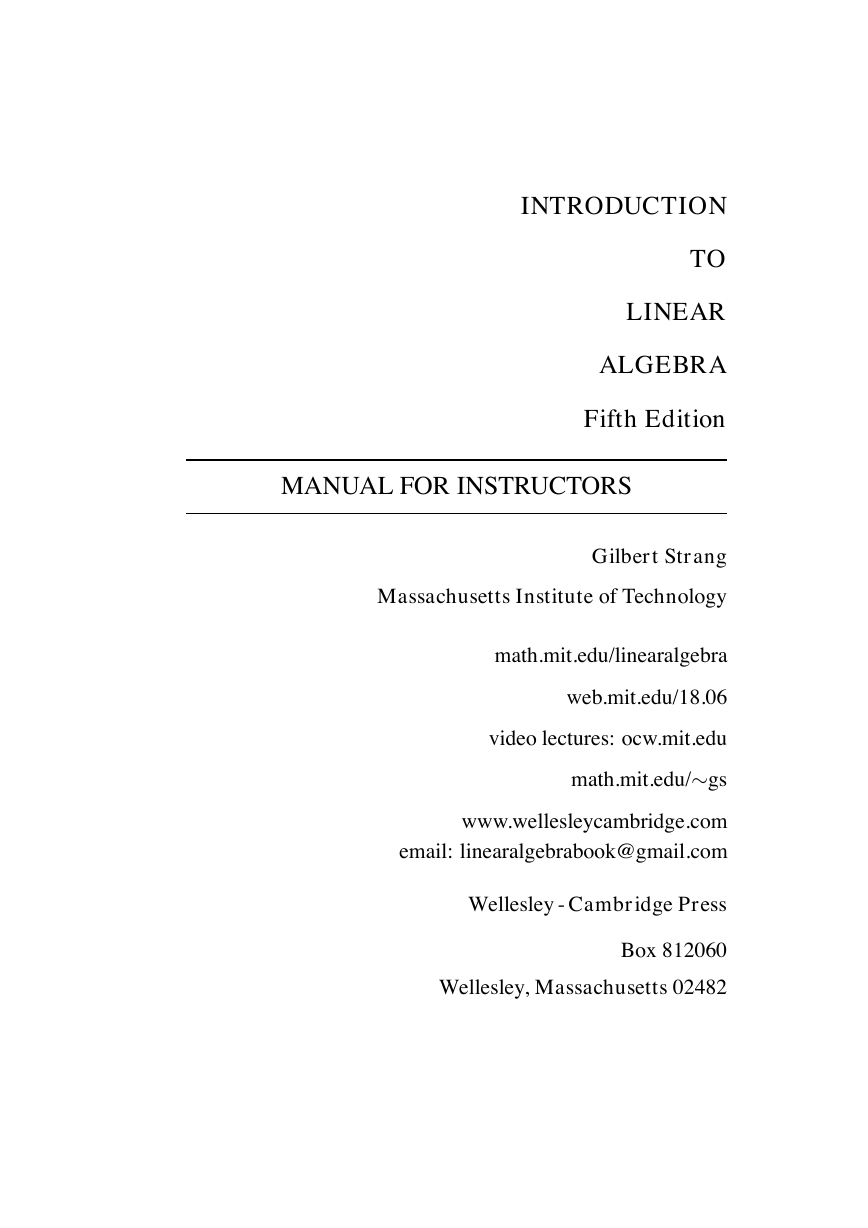
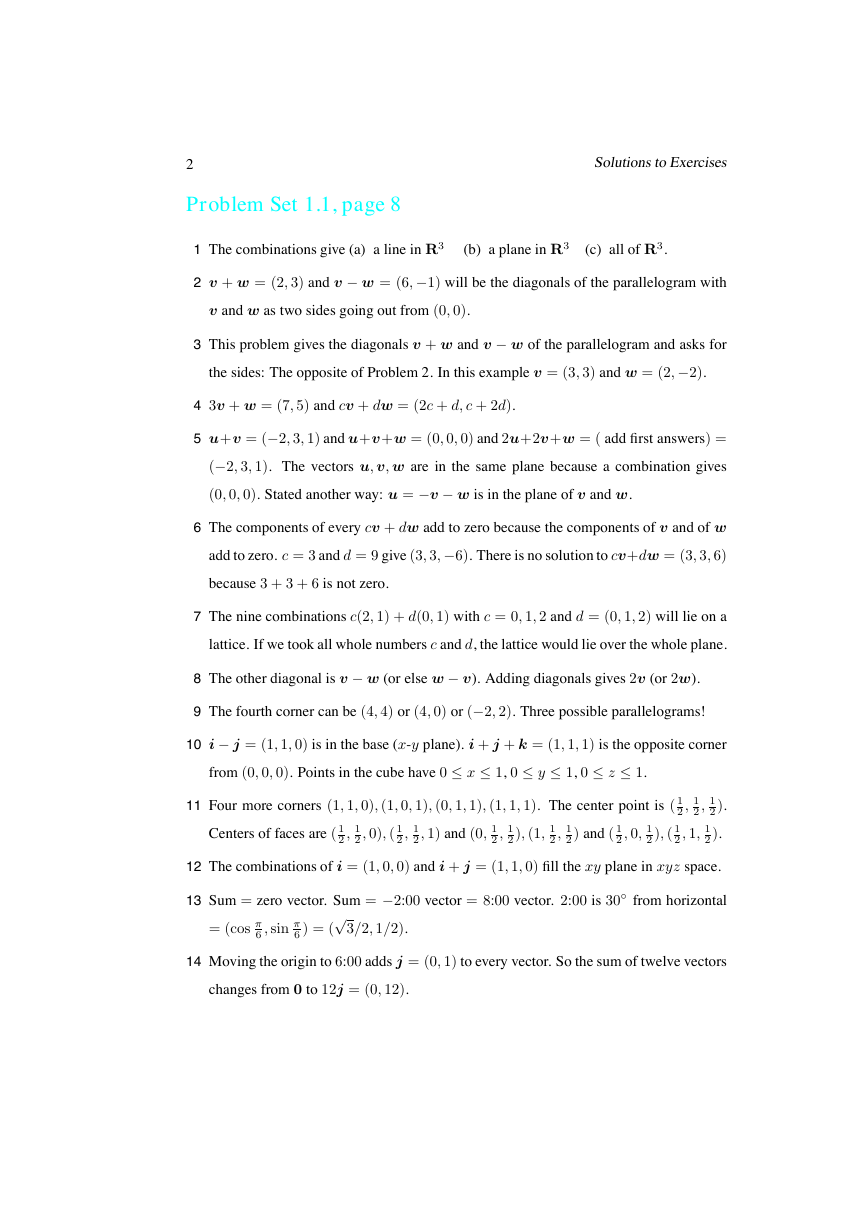
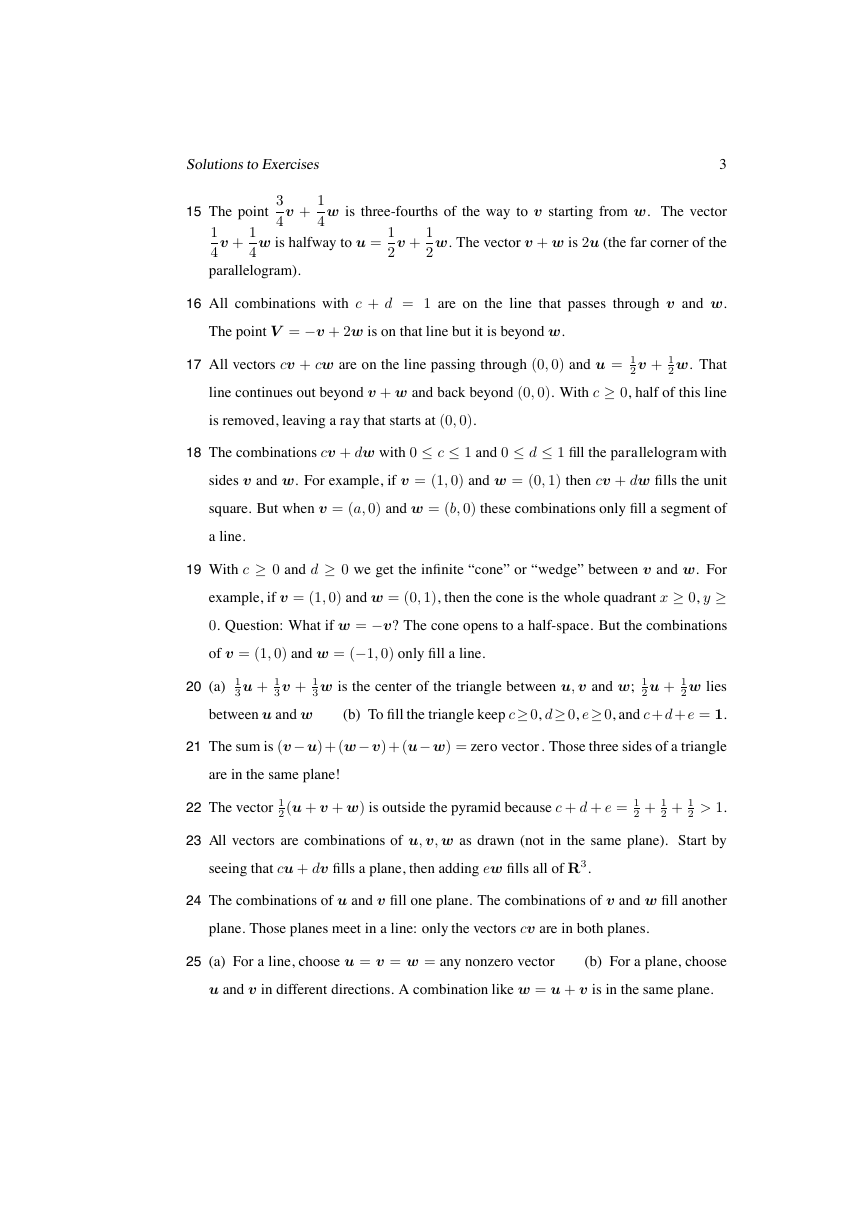

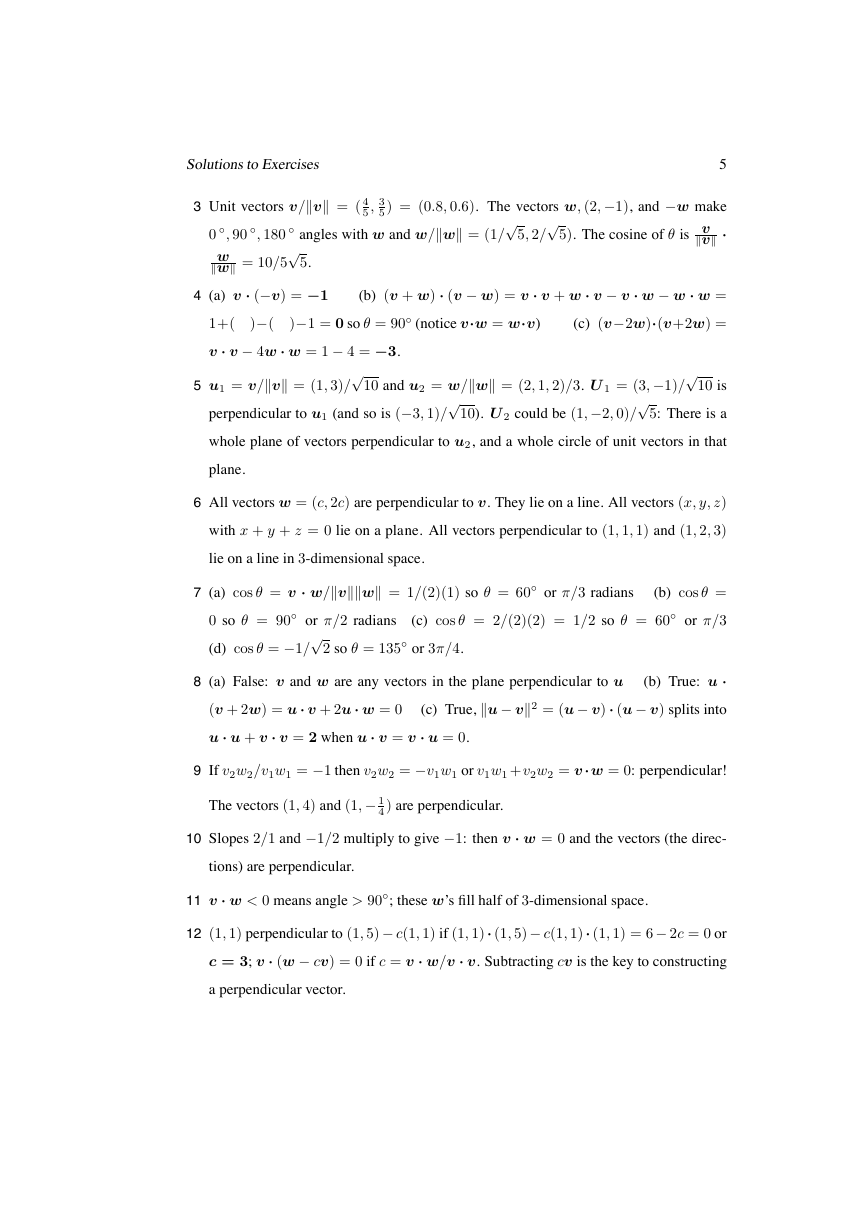
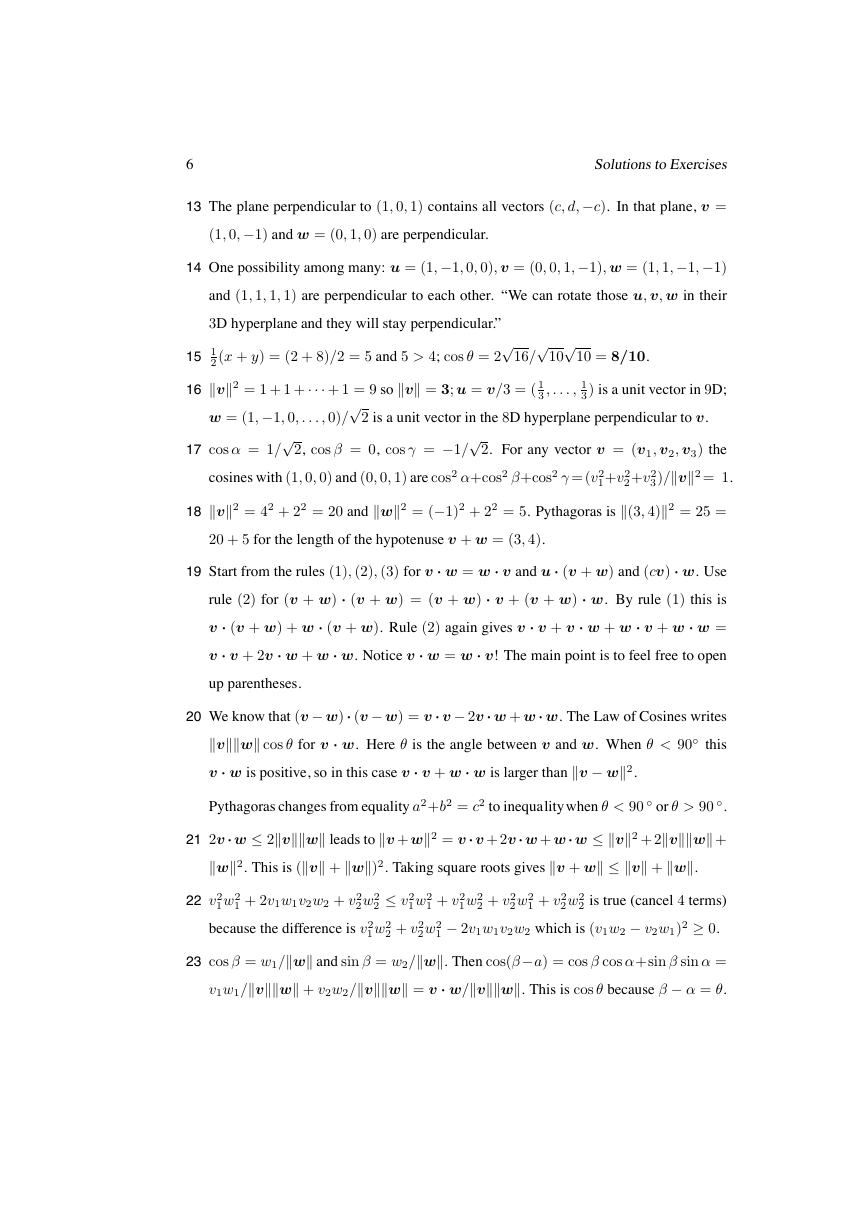
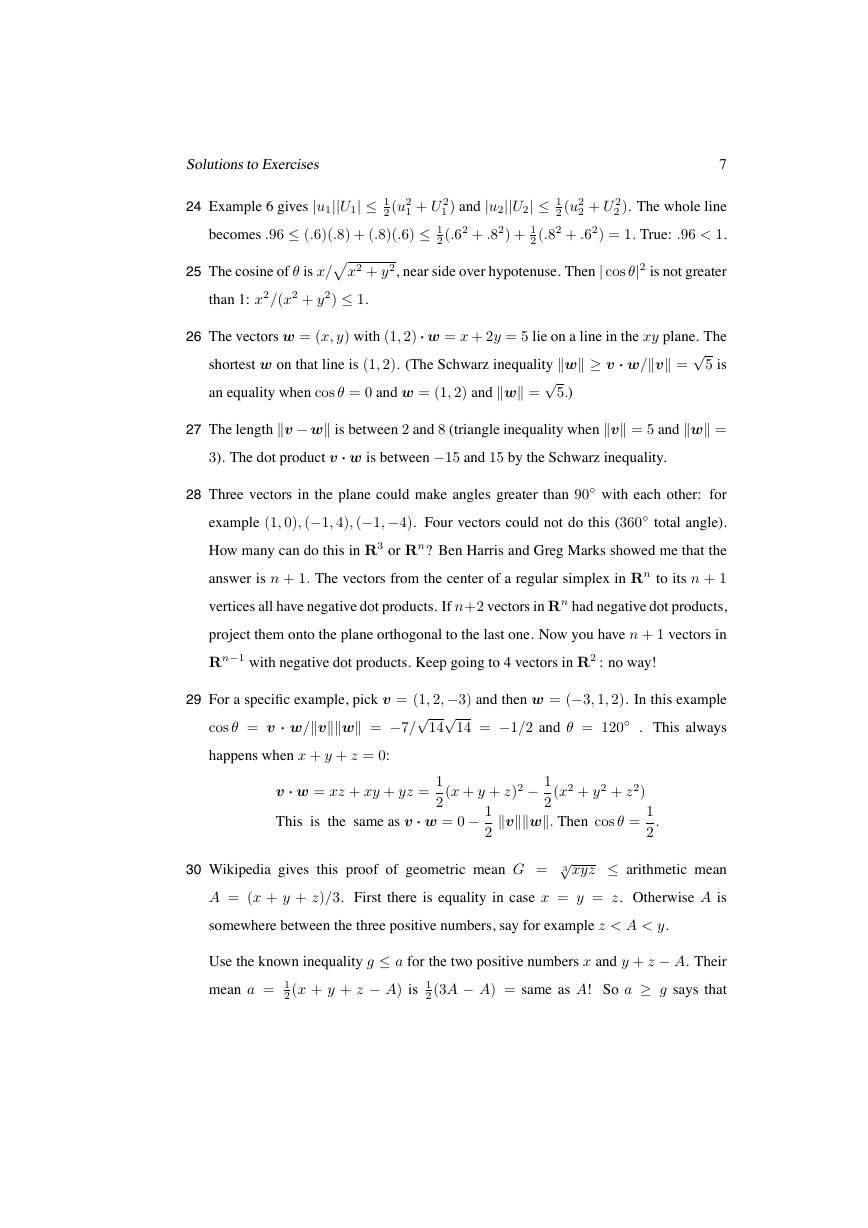
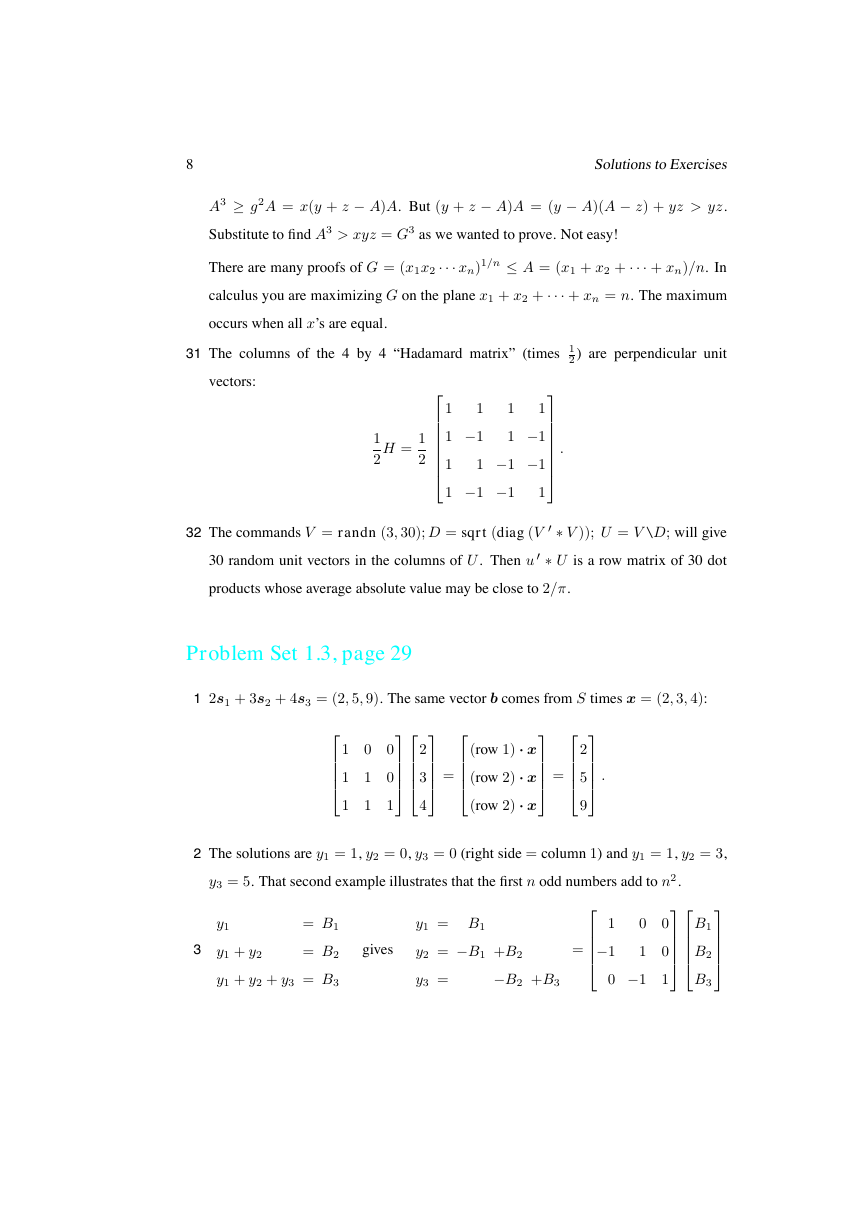








 2023年江西萍乡中考道德与法治真题及答案.doc
2023年江西萍乡中考道德与法治真题及答案.doc 2012年重庆南川中考生物真题及答案.doc
2012年重庆南川中考生物真题及答案.doc 2013年江西师范大学地理学综合及文艺理论基础考研真题.doc
2013年江西师范大学地理学综合及文艺理论基础考研真题.doc 2020年四川甘孜小升初语文真题及答案I卷.doc
2020年四川甘孜小升初语文真题及答案I卷.doc 2020年注册岩土工程师专业基础考试真题及答案.doc
2020年注册岩土工程师专业基础考试真题及答案.doc 2023-2024学年福建省厦门市九年级上学期数学月考试题及答案.doc
2023-2024学年福建省厦门市九年级上学期数学月考试题及答案.doc 2021-2022学年辽宁省沈阳市大东区九年级上学期语文期末试题及答案.doc
2021-2022学年辽宁省沈阳市大东区九年级上学期语文期末试题及答案.doc 2022-2023学年北京东城区初三第一学期物理期末试卷及答案.doc
2022-2023学年北京东城区初三第一学期物理期末试卷及答案.doc 2018上半年江西教师资格初中地理学科知识与教学能力真题及答案.doc
2018上半年江西教师资格初中地理学科知识与教学能力真题及答案.doc 2012年河北国家公务员申论考试真题及答案-省级.doc
2012年河北国家公务员申论考试真题及答案-省级.doc 2020-2021学年江苏省扬州市江都区邵樊片九年级上学期数学第一次质量检测试题及答案.doc
2020-2021学年江苏省扬州市江都区邵樊片九年级上学期数学第一次质量检测试题及答案.doc 2022下半年黑龙江教师资格证中学综合素质真题及答案.doc
2022下半年黑龙江教师资格证中学综合素质真题及答案.doc